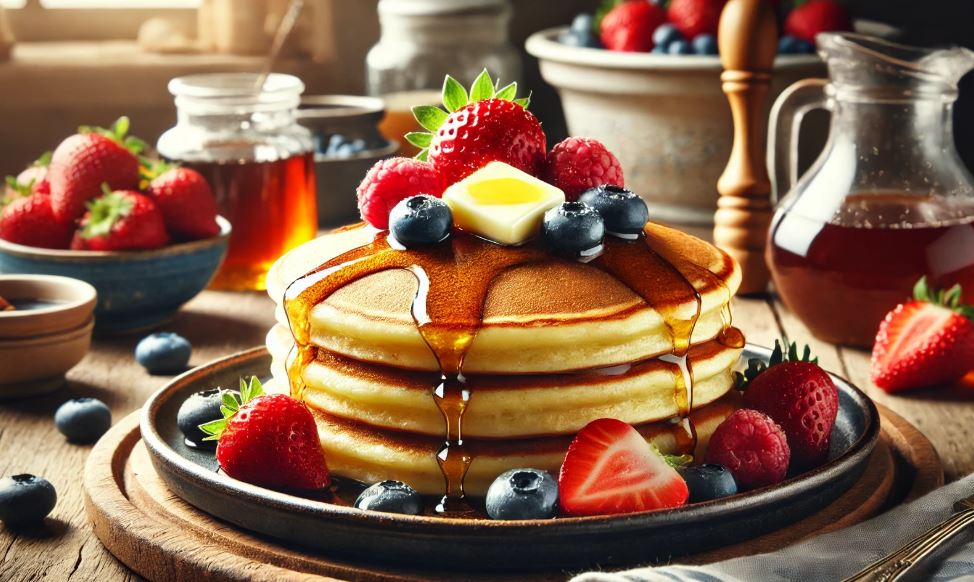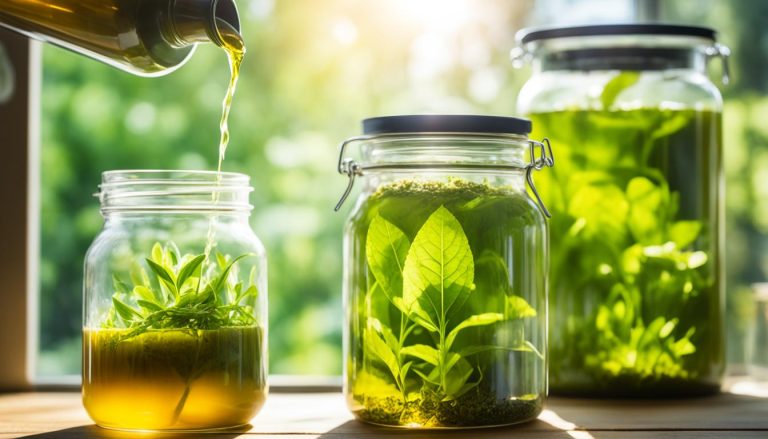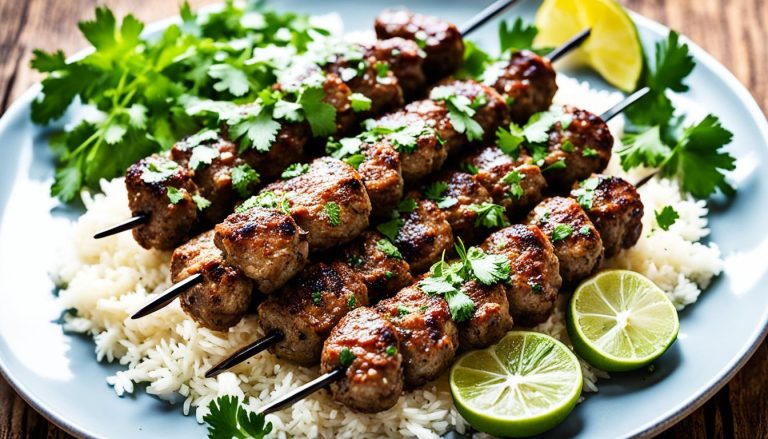As a passionate cook who believes in the magic of simple ingredients, I, Bella Franklin, am thrilled to share a truly timeless breakfast classic: the buttermilk pancake.
Known for their light, fluffy texture and rich flavour, buttermilk pancakes are a staple that can brighten any morning. This recipe is not only easy to follow but also promises consistently delicious results.
In this blog, I will guide you through everything you need to know, from the science behind the fluffiness to various chef-inspired variations you can try at home. Let’s get started on making mornings a little sweeter.
What Is a Buttermilk Pancake?
A buttermilk pancake is a classic American-style breakfast item made using buttermilk, flour, eggs, baking powder, and a few other ingredients.
The defining feature of a buttermilk pancake is its tenderness and fluffiness, often softer and richer than pancakes made with regular milk.
Key Characteristics:
- Fluffy texture with a light, airy centre
- Slight tanginess from the buttermilk
- Golden brown exterior with a soft bite
- Rich flavour without being overly sweet
Buttermilk pancakes have been a part of culinary traditions for centuries, appreciated for their ability to be both hearty and delicate.
Unlike crepes, which are thin and flexible, buttermilk pancakes are thick and designed to absorb syrups, fruit toppings, or even savoury additions. This versatility is part of their enduring appeal.
Whether you are enjoying them with maple syrup or fresh berries, buttermilk pancakes provide a perfect balance between indulgence and comfort.
How Does Buttermilk Make Pancakes Fluffy?
Understanding the role of buttermilk in pancake recipes reveals why it is so important for achieving the perfect texture.
Chemical Reaction
- Buttermilk is slightly acidic. When it interacts with alkaline baking soda or baking powder, it triggers a reaction that releases carbon dioxide bubbles.
- These bubbles get trapped in the batter, creating pockets of air that cause the pancake to rise and become airy.
Additional Benefits
- Enhances tenderness by breaking down gluten
- Provides a tangy flavour profile that balances the sweetness
- Helps in achieving a crisp edge while maintaining a moist interior
Without the acidity of buttermilk, pancakes tend to be denser and less flavourful. This simple scientific process makes buttermilk a crucial ingredient in recipes that aim for superior fluffiness and taste.
What Ingredients Do You Need for Buttermilk Pancakes?
Getting the right measurements is crucial for making the perfect buttermilk pancake. Below is the precise list of ingredients you will need.
| Ingredient | Quantity |
| Plain Flour | 250g |
| Baking Powder | 2 tsp |
| Bicarbonate of Soda | ½ tsp |
| Caster Sugar | 2 tbsp |
| Salt | ½ tsp |
| Buttermilk | 475ml |
| Large Eggs | 2 |
| Unsalted Butter (melted) | 60g |
| Vanilla Extract | 1 tsp |
Ingredient Tips
- Use fresh buttermilk for best results; avoid substitutes when possible.
- Make sure the eggs are at room temperature to help the batter mix evenly.
- Always sift the flour, baking powder, and bicarbonate together to prevent lumps.
This combination ensures the batter has the right consistency and the pancakes cook evenly on the griddle or frying pan.
How Do You Make Classic Buttermilk Pancakes Step-By-Step?
Mastering the classic buttermilk pancake involves careful preparation and attention to a few critical steps.
Step-By-Step Instructions
1. Mix Dry Ingredients: Combine flour, baking powder, bicarbonate of soda, sugar, and salt in a large bowl.

2. Mix Wet Ingredients: In a separate bowl, whisk the buttermilk, eggs, melted butter, and vanilla extract.
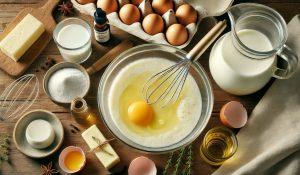
3. Combine Carefully: Pour the wet mixture into the dry ingredients, stirring gently until just combined. Do not overmix; a few lumps are perfectly fine.
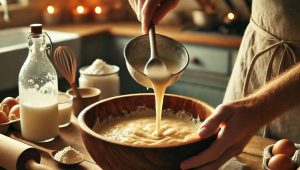
4. Preheat and Grease Pan: Heat a non-stick frying pan over medium heat and lightly grease it with butter or oil.

5. Cook Pancakes: Pour a ladleful of batter onto the pan. Cook until bubbles form on the surface and edges look set, then flip and cook for another minute or two until golden brown.
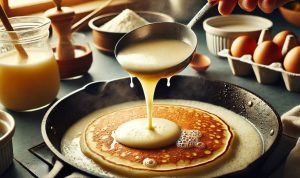
Helpful Tips:
- Use a medium heat to ensure even cooking without burning.
- Flip only once to maintain fluffiness.
- Keep cooked pancakes warm in a low oven (around 90°C) until ready to serve.
Why Should You Use Real Buttermilk Instead of Substitutes?
Although it might be tempting to substitute buttermilk with milk and lemon juice or vinegar, real buttermilk offers distinct advantages.
Key Reasons:
- Authentic buttermilk is thicker and adds a richer texture to the batter.
- The acidity level in real buttermilk is more consistent, ensuring better chemical reactions with leavening agents.
- True buttermilk imparts a tanginess that is difficult to replicate with quick alternatives.
Substitutes can work in a pinch, but for truly exceptional pancakes, sourcing real buttermilk is highly recommended.
How Can You Make Buttermilk Pancakes Extra Light and Airy?
Several professional techniques can elevate your buttermilk pancakes from good to extraordinary.
Proven Techniques:
- Separate the eggs: Whip the egg whites separately and fold them into the batter.
- Do not overmix: Stirring the batter too much can lead to tougher pancakes.
- Let the batter rest: Allowing it to sit for 10–15 minutes helps activate the baking powder fully.
These small adjustments can make a noticeable difference in the finished texture and mouthfeel of your pancakes.
What Toppings Go Best With Buttermilk Pancakes?

Choosing the right toppings can enhance the natural richness of buttermilk pancakes without overpowering them.
Popular Topping Choices:
- Classic Maple Syrup: A timeless option for a reason.
- Fresh Berries: Blueberries, strawberries, or raspberries add a refreshing note.
- Whipped Cream: Light and creamy, perfect for a luxurious touch.
- Toasted Nuts: Pecans or walnuts add crunch and depth.
- Fruit Compotes: Stewed apples or berries bring a lovely contrast.
Experimenting with toppings allows you to tailor each breakfast to your personal taste preferences.
How Can You Store and Reheat Leftover Buttermilk Pancakes?
Proper storage and reheating ensure your pancakes stay delicious even after the first serving.
Storage Tips:
- Allow pancakes to cool completely before storing.
- Stack pancakes between layers of parchment paper to prevent sticking.
- Store in an airtight container in the refrigerator for up to three days.
Reheating Methods:
- Oven: Preheat to 180°C and warm pancakes for about 10 minutes.
- Microwave: Heat individual pancakes for 20–30 seconds.
- Toaster: For a slightly crisp exterior, reheat in a toaster on a low setting.
Reheating properly maintains both the fluffiness and flavour of the pancakes.
What Are Common Mistakes to Avoid When Making Buttermilk Pancakes?
Avoiding simple mistakes can dramatically improve your results when making buttermilk pancakes.
- Overmixing the Batter: Leads to tough, rubbery pancakes.
- Cooking on High Heat: Causes pancakes to burn outside while remaining raw inside.
- Skipping the Rest Time: Batter needs a short rest for optimum fluffiness.
- Using Expired Baking Powder: Affects the rise and texture.
- Flipping Too Early or Too Often: Interrupts the structure and causes uneven cooking.
Taking your time and following a few golden rules ensures a perfect stack every time.
What Are Some Chef-Inspired Buttermilk Pancake Variations?
Over time, many renowned chefs have added their unique twists to the traditional buttermilk pancake recipe.
Gordon Ramsay’s Version
- Incorporates extra whipped egg whites for added lightness.
- Often includes a vanilla pod for an intensified flavour.
Sally’s Baking Addiction Variation
- Suggests adding blueberries directly into the batter for bursts of freshness.
- Recommends browning the butter before mixing it for a nuttier taste.
BBC Good Food Inspiration
- Emphasises pairing pancakes with maple apples and pecans for a seasonal twist.
- Offers guidance on making the batter the night before for a quick morning cook.
NYT Cooking Classic
- Advocates for using a combination of plain flour and cake flour for ultimate tenderness.
- Recommends letting the batter rest for 10 minutes before cooking.
Conclusion
Mastering the buttermilk pancake recipe transforms a simple breakfast into an exceptional experience. With the right ingredients, careful preparation, and a few expert tips, creating fluffy, flavourful pancakes becomes easy and rewarding.
Whether you prefer classic toppings or chef-inspired twists, buttermilk pancakes offer endless versatility and comfort.
By understanding the techniques and avoiding common mistakes, you can enjoy perfect pancakes every time. Start your mornings right with a stack that is light, tender, and truly satisfying.
FAQs
What Can I Use if I Do Not Have Buttermilk?
You can create a substitute by mixing 1 tablespoon of lemon juice or vinegar with 240ml of milk and letting it sit for five minutes.
Can I Make Buttermilk Pancakes Ahead of Time?
Yes, you can prepare the batter a night before and store it in the fridge. Stir gently before cooking.
How Do I Know When to Flip the Pancake?
When bubbles form on the surface and the edges start to look set, it’s time to flip.
Can I Freeze Buttermilk Pancakes?
Absolutely. Stack with parchment paper in between and freeze for up to two months.
Should Pancake Batter Be Thick or Thin?
It should be slightly thick but pourable. Too thick will yield dense pancakes, while too thin will spread too much.
Why Are My Pancakes Flat?
Flat pancakes can result from old baking powder, overmixing, or a batter that is too thin.
Can I Add Chocolate Chips or Fruits Into the Batter?
Yes, adding chocolate chips, blueberries, or bananas directly into the batter enhances flavour.

Buttermilk Pancake Recipe
Ingredients
- 250 g Plain Flour
- 2 tsp Baking Powder
- ½ tsp Bicarbonate of Soda
- 2 tbsp Caster Sugar
- ½ tsp Salt
- 475 ml Buttermilk
- 2 Large Eggs
- 60 g Unsalted Butter melted
- 1 tsp Vanilla Extract
Instructions
- Combine flour, baking powder, bicarbonate of soda, sugar, and salt in a large bowl.250 g Plain Flour, 2 tsp Baking Powder, ½ tsp Bicarbonate of Soda, 2 tbsp Caster Sugar, ½ tsp Salt
- In a separate bowl, whisk the buttermilk, eggs, melted butter, and vanilla extract.475 ml Buttermilk, 2 Large Eggs, 60 g Unsalted Butter, 1 tsp Vanilla Extract
- Pour the wet mixture into the dry ingredients, stirring gently until just combined. Do not overmix; a few lumps are perfectly fine.
- Heat a non-stick frying pan over medium heat and lightly grease it with butter or oil.
- Pour a ladleful of batter onto the pan. Cook until bubbles form on the surface and edges look set, then flip and cook for another minute or two until golden brown.


